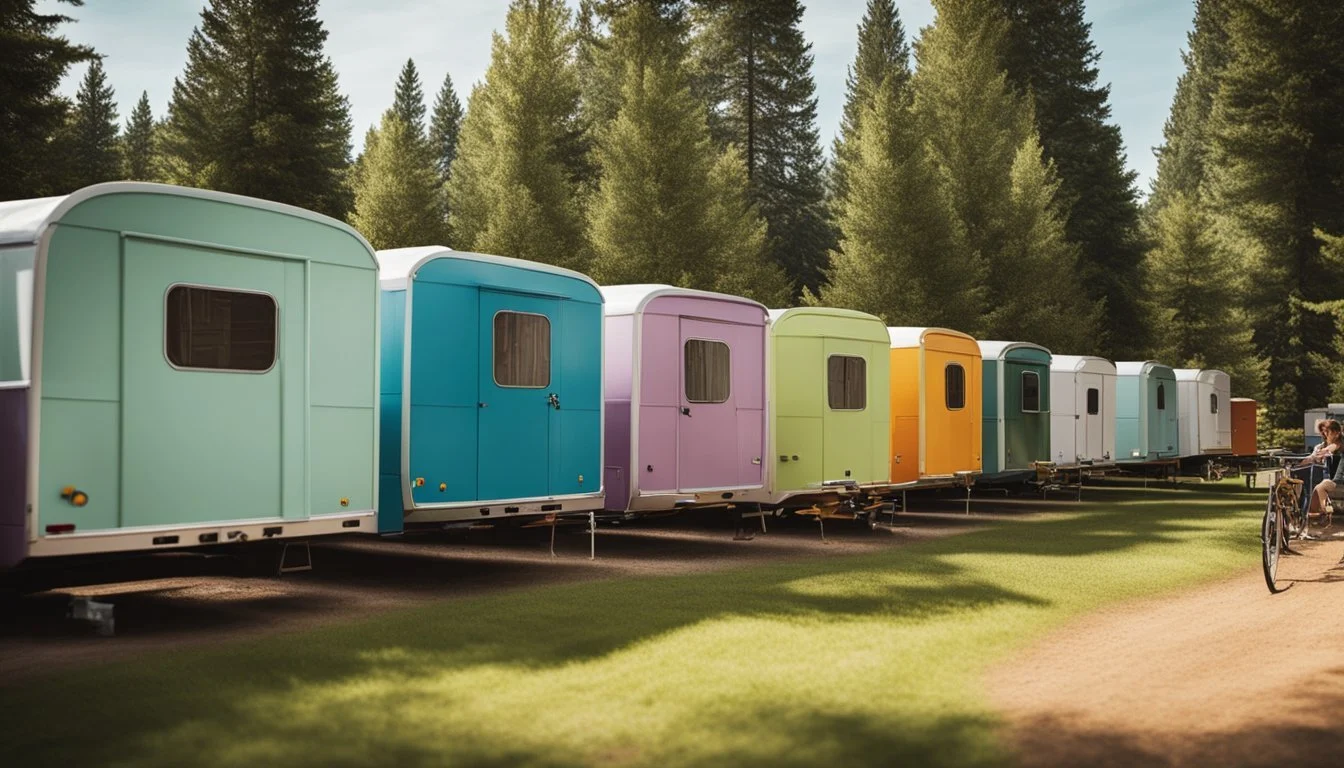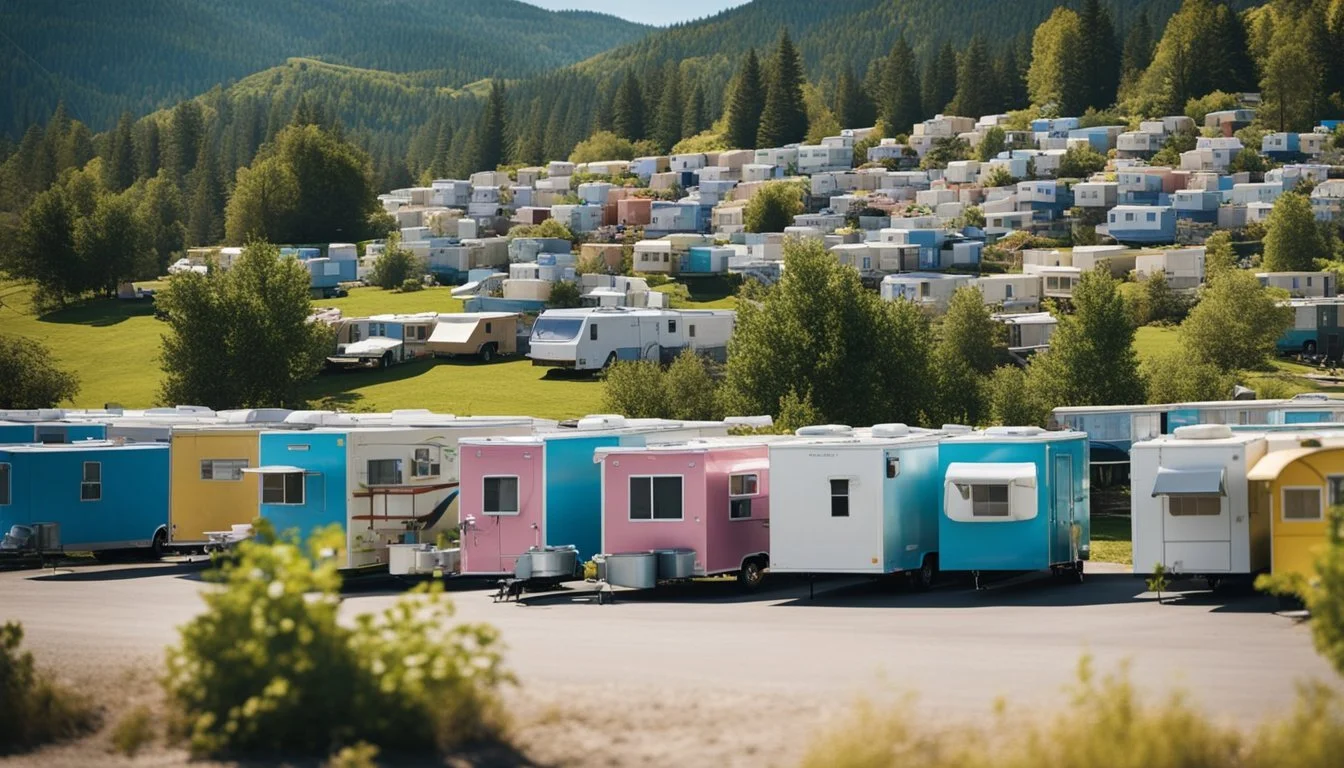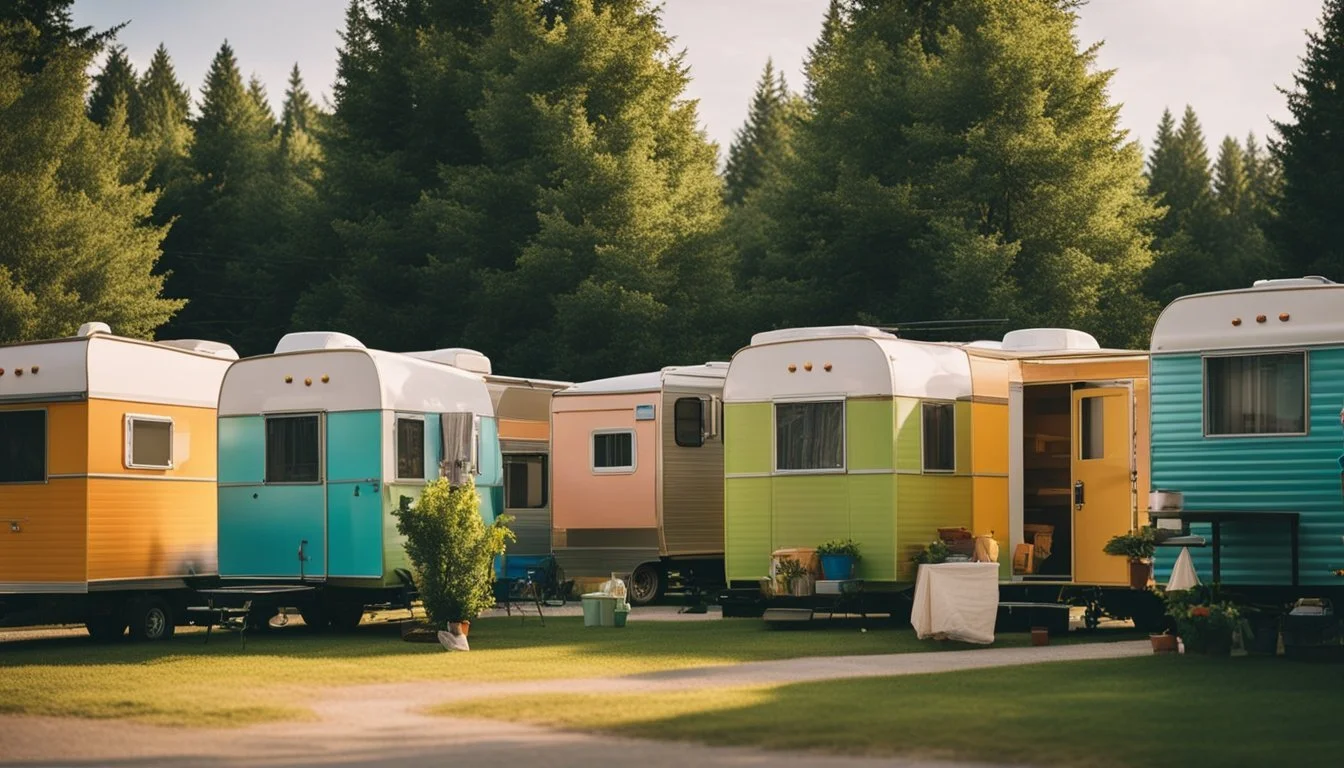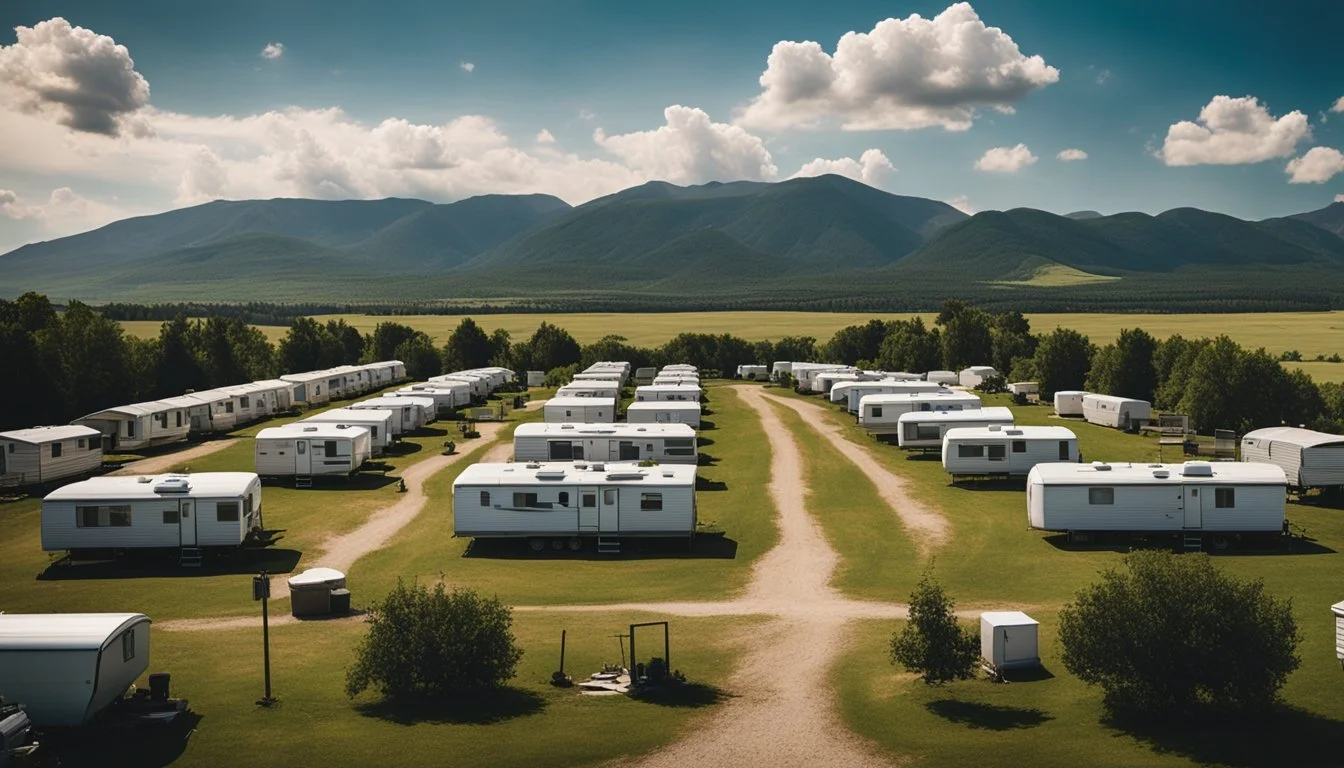How Trailer Parks are Represented in Visual Art
A Photographic Exploration
Trailer parks, often seen as marginalized and overlooked spaces, have emerged as compelling subjects in visual art and photography. Through the lenses of artists like David Waldorf and Kathleen Tunnell Handel, these communities are transformed into rich narratives, challenging the stereotypes associated with them. Waldorf turns mundane trailers into captivating portraits, while Handel delves into themes of community and personal expression within American trailer and mobile home parks.
Visual artists find a unique beauty in the everyday life of trailer park residents, using their work to explore broader social issues such as affordable housing and personal identity. This perspective provides a window into a world that many might not otherwise notice, highlighting both the individuality of the residents and the common challenges they face. The juxtaposition of stark realities and intimate moments captured in these mediums invites viewers to reconsider and appreciate the complexities of life within these communities.
The art of photography in capturing trailer park life goes beyond mere representation; it tells a story of humanity and resilience. Works like Jeffrey A. Wolin's "Pigeon Hill Portraits" offer historical insight, depicting changes over time while emphasizing personal stories. These artistic portrayals engage audiences by shedding light on parts of America that are seldom the focus of mainstream narratives, making them vital pieces in the broader conversation on social structures.
Historical Context of Trailer Parks in Art
Trailer parks have been a focal point in visual art and photography, often serving as symbols of economic struggle and social dynamics. The representation has evolved to encompass various aspects of American life, shedding light on poverty, class, and racial segregation.
The Depiction of Poverty and Class in the 20th Century
Throughout the 20th century, trailer parks were emblematic of both the aspirations and hardships faced by many Americans. During the Great Depression, trailers were often depicted as affordable housing options for families struggling with unemployment.
Artworks and photography from the era highlighted these communities as battlegrounds of class disparity, sometimes invoking themes reminiscent of pieces like American Gothic. By 1942, mobile homes began symbolizing a transient lifestyle, often viewed critically in art for reflecting the harsh realities of poverty.
As the 1950s progressed, atomic age optimism contrasted sharply with the gritty portrayal of trailers. In 1956, they became iconic backdrops for works critiquing post-war economic policies. Artists captured how trailer parks stood as stark reminders of an uneven American dream while investigating themes of mobility and stability.
Racial Segregation and Its Portrayal
Racial segregation further complicated the narrative surrounding trailer parks. In many parts of the United States, these communities were shaped by racial lines, echoing the broader exclusionary practices of the time.
Visual art captured these dynamics, illustrating how segregation policies affected the living conditions and social cohesion within these parks. Paintings and photographs emphasized restricted access and unequal opportunities, vividly depicting the stark walls of racial boundaries.
By highlighting the interplay of segregation and trailer park life, art from this era provided a commentary on American social policies. It offered visceral imagery of the divides that persisted even within these modest communities, forcing viewers to confront the lingering racial inequities.
Influential Artists and Photographers
Artists and photographers have shaped the narrative around American trailer parks through their impactful work. Gordon Parks played a crucial role in highlighting social themes, while other visual storytellers have captured the essence of these unique communities.
Gordon Parks and the Fight for Civil Rights
Gordon Parks used his photography to shine a light on social injustices. His most notable work, American Gothic, Washington, D.C., features Ella Watson, a government charwoman, and is a powerful commentary on racial inequality. Through assignments at Life Magazine, Parks documented the daily lives of African Americans, revealing the humanity within marginalized communities.
His work in Fort Scott and Harlem further amplified the voice of the oppressed. Beyond photography, Parks collaborated with Charles White and other artists, ensuring that the visual narrative of American society included diverse perspectives. His commitment to civil rights has left a lasting legacy that resonates with the fight for equality today.
Other Visual Storytellers of American Trailer Parks
Numerous artists have documented life in American trailer parks, capturing the simplicity and resilience of these communities. Through both photography and painting, these visual storylines present trailer parks as places of both hardship and vibrant life.
Using art as a medium, these creators provide an intimate look into the struggles and joys found within trailer parks, challenging preconceived notions. Their work often uncovers deeper narratives about American society and brings visibility to communities often overlooked by mainstream media. These artists contribute to a vast tapestry of American art, enriching it with diverse stories and perspectives.
Thematic Exploration in Trailer Park Imagery
Trailer park imagery in visual art and photography often delves into the dynamics of family and community. They capture the essence of the American Dream, and confront issues of racism and inequality, revealing underlying social tensions.
Family, Community, and the American Dream
Visual representations of trailer parks frequently highlight themes of family and community bonds. Despite often being depicted as marginalized spaces, these communities are depicted as tight-knit environments where residents support each other.
The ubiquitous presence of the American Flag in these settings symbolizes a complex relationship with national identity and aspirations.
Artists capture scenes of everyday life, portraying both the aspirations and struggles of those who view trailer parks as a step towards achieving the American Dream. The focus is not only on individuality but on collective resilience as well.
Struggles Against Racism and Inequality
Imagery within trailer parks also addresses broader societal issues such as racism and inequality. Historically, these environments have been portrayed as predominantly white spaces, commonly linked to economic poverty and stereotypical labels.
Photographers and artists challenge these perceptions by documenting the diverse African American Community and other marginalized groups within these parks. Such depictions aim to highlight the ongoing struggles against systemic racism and inequality within American society.
By juxtaposing personal stories against the backdrop of broader societal issues, visual art in trailer parks serves as a potent medium to reflect on the ongoing impacts of the Civil Rights Movement and spotlights the efforts of individuals striving for equality.
Artistic Techniques and Storytelling
The representation of trailer parks in visual art and photography often involves careful consideration of lighting, composition, and mood. Documentary photography plays a crucial role in capturing the reality and narratives inherent in these environments.
Lighting, Composition, and Mood in Photography
In photography, lighting serves as a tool to highlight textures and contours of the trailer parks, creating different moods. Soft lighting can evoke a sense of calm, while stark contrasts might highlight elements of tension or rugged beauty.
Composition involves strategically framing scenes to emphasize particular aspects of the trailer parks. Leading lines, symmetry, and framing can enhance the depiction of space, drawing attention to elements like the geometry of trailers or surrounding landscapes.
Mood is a product of how these elements interact. By manipulating composition and lighting, photographers can convey emotions ranging from isolation to community. They craft narratives that engage viewers, stimulating reflection on the lives within these spaces.
Documentary Photography and Its Impact
Documentary photography captures the everyday realities of trailer park life, often shedding light on socio-economic issues. This style records genuine moments, allowing audiences to engage with the subjects on a personal level.
Impactful storytellers use documentary methods to depict authenticity. They present the parks not merely as objects of artistic interest but as living communities with complex social dynamics.
Through documentary work, photographers reveal unseen aspects of trailer parks, challenging stereotypes and fostering empathy. The art form can influence perceptions by providing a balanced view, which highlights beauty, hardship, and the resilience found in these communities.
Contemporary Representation and Perspectives
Visual art and photography increasingly explore the complex narratives of trailer parks. Modern photography, enhanced by social media, brings attention to the realities of these communities. Emerging artists provide fresh perspectives by highlighting both struggles and resilience within trailer parks.
Modern Photography and Social Media Influence
Modern photography plays a crucial role in shaping how trailer parks are perceived. Photographers like Latoya Ruby Frazier document these settings with authenticity, offering a glimpse into the lives of residents. Social media platforms amplify these visuals, reaching a broad audience that might otherwise overlook these nuanced stories.
The accessibility of platforms like Instagram allows photographers to share their work instantly while engaging with the community in meaningful ways. This real-time interaction fosters discourse and facilitates an understanding of trailer parks' social dynamics.
Emerging Artists and Their Views on Trailer Parks
Emerging artists are redefining the narrative around trailer parks through their innovative approaches in contemporary art. They focus on portraying the resilience and strength of people living within these communities. By doing so, they challenge stereotypes and encourage viewers to reconsider preconceived notions.
Art exhibits often showcase these works, providing a platform for artists to express unique views. These representations aim to highlight both the challenges and the beauty found in these environments. Engaging with topics such as economic struggles and community bonds, they offer a more personalized view of life in trailer parks.
Socioeconomic and Political Narratives
Visual art and photography often serve as powerful tools to communicate socioeconomic disparities and political issues surrounding trailer parks. This section explores the intersection of class and economic power, as well as the role of activism in art, focusing on how visuals address socio-political themes.
Discussions of Class and Economic Power
Images depicting trailer parks frequently highlight issues of class disparity and economic power dynamics. These visuals reveal the reality of communities often marginalized by mainstream society. Trailer parks, associated with lower economic status, expose the stark contrast between wealthy and disadvantaged groups.
Class struggles become evident in these portrayals, offering viewers a vivid illustration of inequality. The use of imagery not only opens a window into the financial hardships faced by residents but also challenges stereotypes perpetuated about these communities. This enables a broader conversation around economic disparity, pushing societal reflections on wealth distribution.
Activism and Art: Protests in Visuals
Activism in art captures the spirit of social movements within trailer park communities. Photographs and paintings often reflect protests and activism, highlighting demands for social justice and better living conditions. These visuals offer a platform for raising awareness about the struggles and aspirations of residents.
Art associated with these movements portrays not just moments of protest but also aims to inspire change. By visually documenting rallies and gatherings, artists contribute to the wider narrative of advocacy, ensuring that the voices of these communities are heard. Such representation serves as both a historical record and a catalyst for ongoing dialogue and reform efforts.
Impact and Legacy of Trailer Park Representation
The representation of trailer parks in visual art and photography has a significant role in shaping perceptions and attitudes. It highlights key societal issues, serving both as a cultural artifact and educational tool to address misconceptions and promote understanding of marginalized communities.
Influence on Visual Art and Popular Culture
Trailer parks have been a rich subject for visual artists who explore themes of resilience and culture. These settings often depict a juxtaposition of economic hardship and vibrant community life, offering a glimpse into lives often overlooked. Artists use photo essays and exhibitions to challenge stereotypes, making trailer parks emblematic of broader societal issues. Their work disrupts the conventional notions of "home" through vivid portrayals that encourage viewers to engage with subjects empathetically.
In popular culture, trailer parks often symbolize economic struggle and resilience. Films and television shows frequently incorporate these settings to convey themes of injustice or social disparity. Through these representations, viewers gain an awareness of the economic and social challenges faced by residents, contributing to a broader cultural narrative that prompts dialogue about class, identity, and the definition of the American dream.
Educational Value and Cultural Understanding
Visual art and photography of trailer parks also serve educational purposes by fostering cultural understanding. By showcasing everyday life, they provide insight into the dynamics and routines of these communities, dispelling myths and offering authentic presentations of resilience and camaraderie. This educational value is immense, as it equips audiences with a nuanced perspective often absent from mainstream discussions.
Artists and photographers highlight societal injustices through their work, creating a platform for education and advocacy. These representations encourage audiences to reconsider preconceived notions, offering an opportunity to learn about and empathize with the diverse experiences within trailer parks. Engaging with such work facilitates greater cultural understanding, challenging stereotypes, and promoting a more inclusive view of American society.
Case Studies and Iconic Images
In the exploration of trailer parks in visual art and photography, certain works stand out for their powerful portrayal and impactful narrative. Through specific case studies and iconic images, connections between cultural representations and social commentary can be deeply understood and appreciated.
Analysis of Gordon Parks' Seminal Works
Gordon Parks was an influential African American photographer whose work often focused on themes of racial and social issues. Among his most notable works is "Harlem Gang Leader," which shed light on the struggles of Black Americans in Harlem.
His photographic essays helped humanize his subjects and emphasized the urgent need for social change. Parks’ work in documenting the lives of individuals within trailer parks also highlights his ability to capture the essence of marginalized communities. Though primarily known for images of urban poverty, Parks' approach resonates with broader issues of displacement and poverty, relevant to trailer parks.
Comparative Studies of Representations Across Decades
Representations of trailer parks have evolved over the decades, reflecting societal attitudes and economic conditions. In the mid-20th century, artists often depicted trailer parks as symbols of transient existence and economic struggle.
Contrastingly, contemporary photographers sometimes challenge these stereotypes, focusing instead on community and resilience. This shift is apparent in the juxtaposition of Parks’ earlier work with newer interpretations that celebrate diversity within these communities.
A comparative study reveals how perceptions of trailer parks have shifted from solely negative connotations to more nuanced, empathetic portrayals, showing the dynamic nature of visual representation. Through the examination of these images, the changing narrative around trailer parks and their residents becomes clear.
Galleries and Public Exhibitions
Visual art and photography that explore trailer parks often find their way into galleries and public exhibitions. These spaces provide a platform for artists to challenge stereotypes and offer nuanced perspectives. They serve as vital venues for both emerging and established voices to engage audiences.
Major Exhibitions Featuring Trailer Park Themes
Major exhibitions often place an emphasis on the themes present in trailer parks, reflecting broader societal issues. Noted for its exploration of everyday American life, Gordon Parks' work, while not strictly on trailer parks, provides a backdrop for understanding how art can engage with issues of living conditions and economic challenges. His exhibitions have appeared in esteemed venues like the Howard Greenberg Gallery.
Other exhibitions focus directly on the trailer park lifestyle, showcasing works in public and private galleries. These exhibitions often partner with academic institutions and civil rights organizations to reach a diverse audience. They emphasize community, resilience, and expressions of identity within these unique environments, often juxtaposing the themes with other aspects of American life such as fashion and memoir-inspired narratives.
The Role of Public Institutions in Showcasing This Genre
Public institutions, including museums and galleries, play a crucial role in promoting visual art and photography centered on trailer parks. These institutions ensure that art reflecting this lifestyle is accessible to the public, offering exhibitions that challenge preconceptions and inspire discussions.
Supporting artists through grants and artist residencies allows for deeper exploration into the subject matter. These institutions often collaborate with artists to ensure their work is both impactful and authentic. Partnerships with education and community organizations broaden the reach and understanding of these themes, illustrating how they fit into the larger tapestry of American art and culture.










